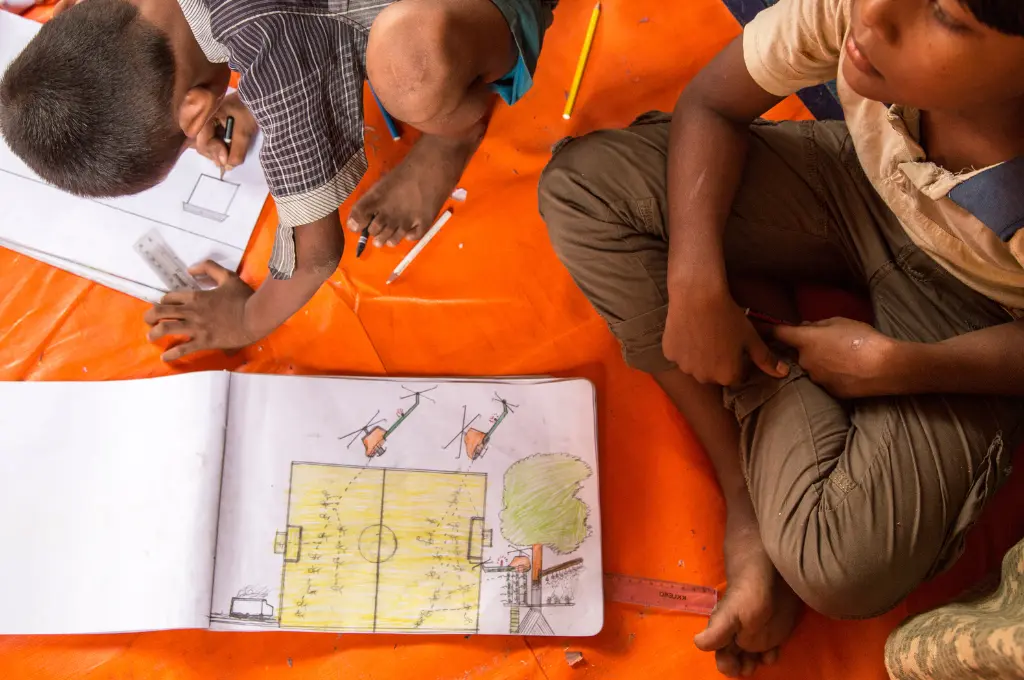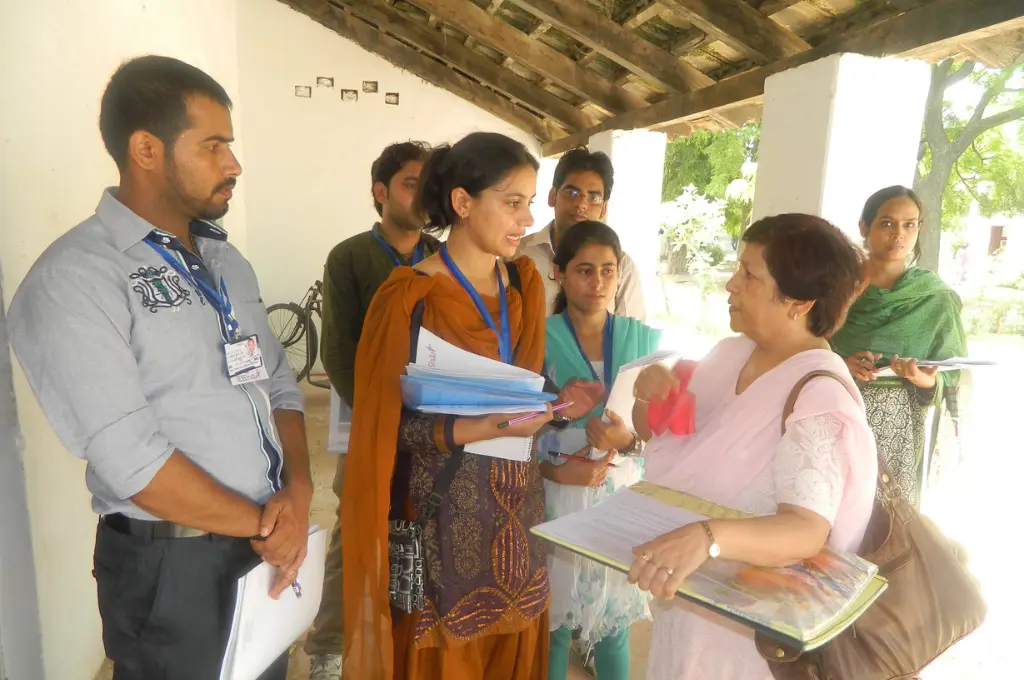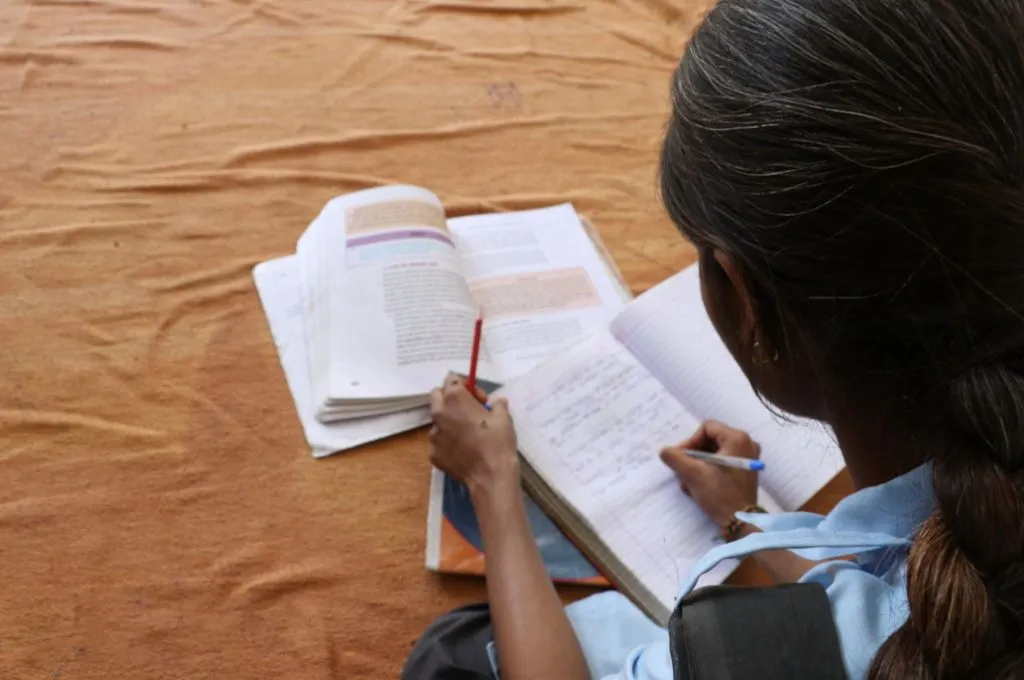Research shows that under traditional conditions in India,1 a surveyor’s gender influences a woman respondent’s responses to sensitive questions regarding maternal and child health, and preferences. Therefore, it can be beneficial to have women surveyors interview women respondents. Regardless of age, race, and educational level, because of social norms, many women are not allowed to communicate with men (other than their husbands) about female-specific issues such as: childbirth, menstruation, contraception, breastfeeding, and domestic violence. As a result, they often feel hesitant to speak openly with male surveyors.
As IDinsight conducts surveys in small towns or villages, honest answers can only be expected when female respondents feel comfortable with the surveyor. For this to be possible, it is important that the survey team have female representation along with some experienced staff to ensure that challenges faced in the field and those in a rural environment are handled well.
We recently completed data collection with about 3,000 women in Rajasthan. These in-person surveys were conducted by a team of 200 women surveyors over a period of three weeks. At the end of the data collection exercise, we conducted a brief qualitative survey with our surveyors to understand what made their data collection experience easy and inspiring. This blog offers three things we learned—based on my experience—and suggestions for working with women surveyors.

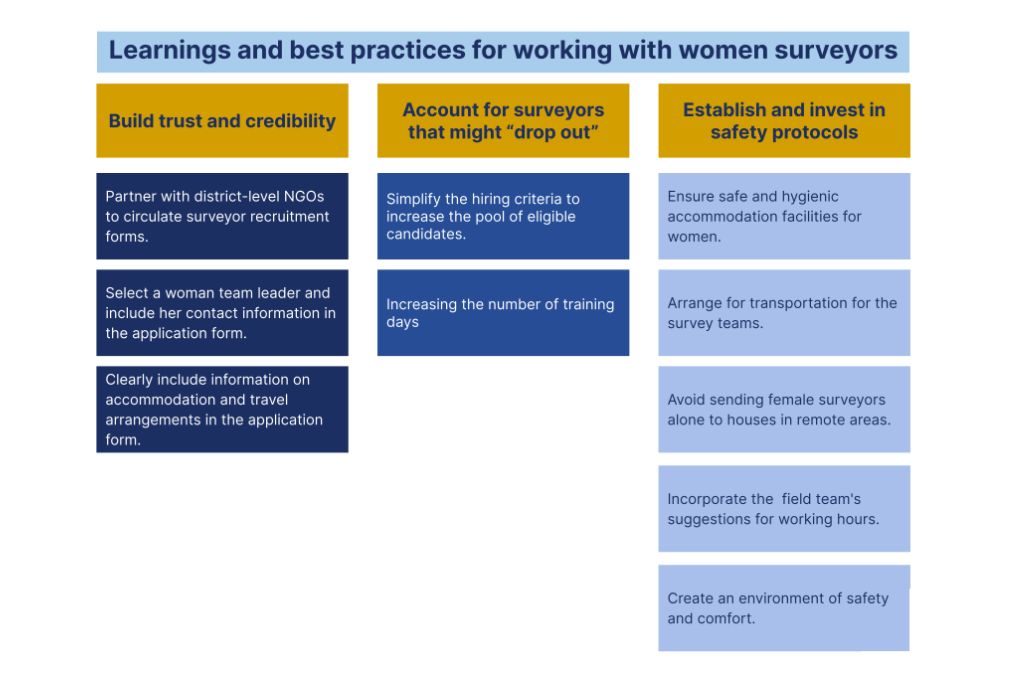
Lesson #1: Build trust and credibility
1. Partner with district-level NGOs to circulate surveyor recruitment forms:
Hiring in a new geography is challenging because candidates find it hard to trust organizations they may not know about. Thus, even if the recruitment forms reach them, they (especially women) are hesitant to apply for the role. To overcome this challenge, we introduced ourselves, as IDinsight, to well-known local NGOs that work on gender issues in the regions where we were planning to collect data. We sought their help in circulating the surveyor application forms. Referred forms from trusted NGOs helped ease women’s hesitations and helped build rapport with IDinsight. This proved beneficial for us as we received ~1,200 applications (from within and outside of Rajasthan), out of which many candidates were new, first-time surveyors. After conducting all stages of the hiring process, we selected 235 surveyors and called them to confirm their selection.
2. Select a woman team leader and include her contact information in the application form:
The surveyor application form for female surveyors must include the contact information of the female team leader (District Coordinator, State Coordinator, and the Field Manager). Being aware of the presence of a female team leader can help women candidates feel more comfortable applying for the role and reaching out to the team lead for queries or challenges they might face.
3. Clearly include information on accommodation and travel arrangements in the application form:
The application form must clearly detail the travel and accommodation arrangements that will be provided to female surveyors during data collection. This will help women more deeply gauge potential safety risks associated with travel.
Lesson #2: Account for surveyors that might drop out
Even after hiring an additional 15-20% of required candidates, women dropped out in large numbers up until the training day. Most female surveyors dropped out because the job entailed a short period of data collection (approximately 15 days including training): This discouraged candidates from continuing since their families were not supportive of work that lasted only for a few days, while also requiring travel outside their hometowns. This challenge was magnified when, due to internal timeline constraints, the start date of data collection shifted two to three times.
We tried the following to address surveyor dropouts:

1. Simplify the hiring criteria to increase the pool of eligible candidates:
We conducted a new recruitment drive for about 30% of the required surveyors. For this, we removed the requirement that surveyors have previous experience in our hiring criteria so that new surveyors could also be eligible. This expanded the pool of eligible candidates and enabled us to reach the target number of female surveyors that were needed.
2. Increase the number of training days:
Since many new surveyors were hired, we staggered the training programme over a higher number of days to ensure better learning and retention on survey protocol, SurveyCTO application (digital medium of data collection), and survey administration.
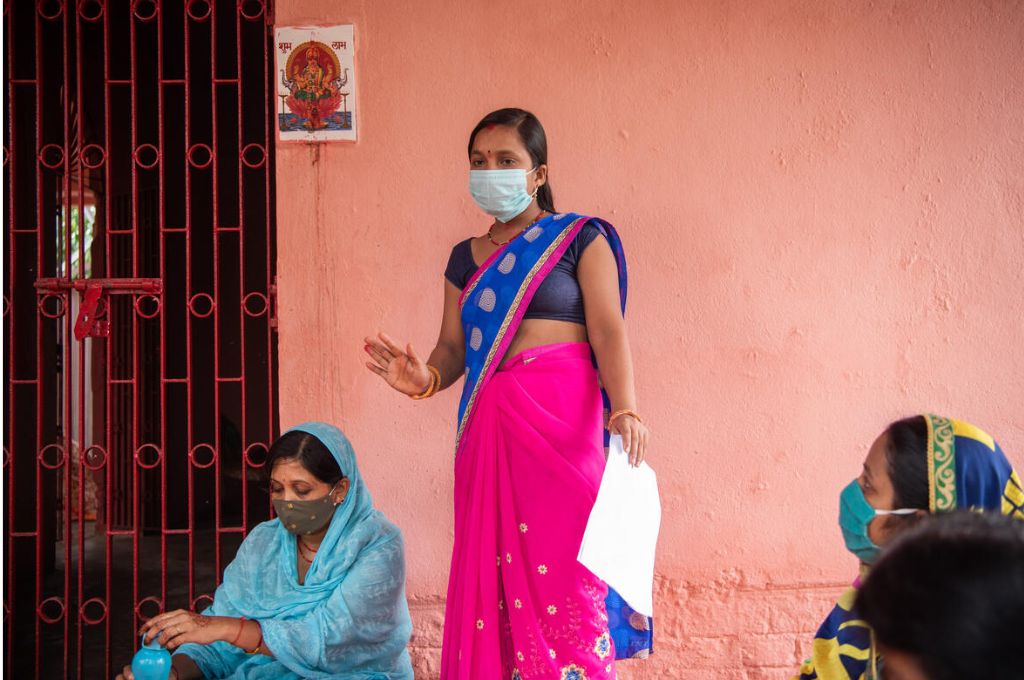
Lesson #3: Establish and invest in safety protocols
Ensuring safety and security is of prime importance while working with an all-women team. Based on a qualitative survey with our female surveyor team to seek their input on this, the following key recommendation emerged:
1. Ensure that there are safe and hygienic accommodation facilities for women:
During surveyor training and data collection, it is important to provide the surveyor team with safe accommodation facilities. To achieve this, our district coordinators identified such houses and facilities that were available for rent from families already living in them. This had the added benefit of providing assurance to surveyors, and their families, that they will reside in secure facilities and will not face any problems.
“It is important to both make arrangements for safe accommodation and also communicate the same during the time of hiring and training since this is a key concern for families.” — Surveyor
2. If possible, arrange for transportation for the survey teams.
We arranged for 3-4 cabs in each of our survey districts to ensure that teams were able to travel safely together. We also observed that in comparison to other means of transport (like buses), traveling in cabs increased the productivity of survey teams due to lesser travel time and more comfort.
We found that cabs were preferable to other modes of transportation such as:
- Motorbikes: The proportion of women who drive motorbikes is comparatively lower than men, especially in rural areas. Due to this, it is difficult to find motorbike-driving female surveyors.
- Public transport: Undertaking fieldwork through public means of transport can be difficult due to low availability in rural areas and the need to take lifts. Further, it increases the travel time due to poor last-mile connectivity of buses and uncertain travel schedules. If the surveyors are unable to catch the bus on time, they might find it very difficult to return home.
“The availability of cars to undertake fieldwork enabled us to travel and complete surveys in a safe and timely manner.” — Surveyor
3. Avoid sending female surveyors alone to houses in remote areas:
In villages, some houses are located either in remote areas or away from the general population. To reach these houses, surveyors may need to cross farms, mountains, and rivers on their own, which may be unsafe for female surveyors in particular. We ensured that data collection from such houses was completed either at the end of the data collection activities or on a day on which the team leader or at least two other female surveyors could accompany them.
It is not advisable to send female surveyors alone to remotely-located homes in villages, especially when they may need to cross farms and rivers.
4. Incorporating field team’s suggestions for working hours:
As we know, there is a lot of uncertainty in fieldwork. But, it is still important to take suggestions from the team after the start of data collection to understand whether women feel safe and comfortable with working hours. Based on feedback from our surveyors after the first two days of data collection, we modified the daily routine of the field team. We left for the field from our place of stay early in the morning (7 am) after breakfast and returned home by evening (3-4 pm). This not only ensured safety, but early morning departure also increased the chances of meeting respondents at home and improved productivity.
“The time to leave for the field should be early, so that we can return from the field early and reach our place of stay before dark.” — Surveyor
5. Create an environment of safety and comfort:
About 70% of the female surveyors in the team were working outside their hometown for the first time. In order to create a safe and comfortable environment for them, from the very first day of training, we made small groups and gave responsibility to an experienced female surveyor in the same group to extend their support if any member of their group faced any problem. We encouraged the surveyors to freely share any problems that they may face. Along with this, we provided sanitary pads, essential medicines, and face masks to all surveyors.
Some women surveyors said that after working in the field, they felt empowered and gained confidence. Many of these women now serve as an example in their communities, which gives confidence to other women in their village interested in engaging in work outside their homes. Apart from this, after learning about the survey topic, they passed on their experiences to the people in their families and community. Many of the surveyors who worked with us for the first time are now continuing to work in different organizations.
“Once we stayed outside home for work for the first time, it built trust and confidence among the family members. Now we are allowed to work outside without any resistance.” — Surveyor
Though we still have a long way to go to increase the number of women surveyors, we can significantly increase their participation by ensuring these best practices. Please share any tips that have helped your work or that of your organization in the comments.
Acknowledgement
I deeply appreciate the comments and reviews on this blog from my colleagues at IDinsight. Thank you, Ashruth Talwar, Ritika Rastogi, Fahad Hasin, Mitali Mathur, Purnima Ranawat, Akshita Sharma, Vasundhara Chauhan, and Emily Coppel.
This article was originally published on IDinsight.
—
Footnotes:
- Readers should note that these tips emerge from my experience of working in India.


